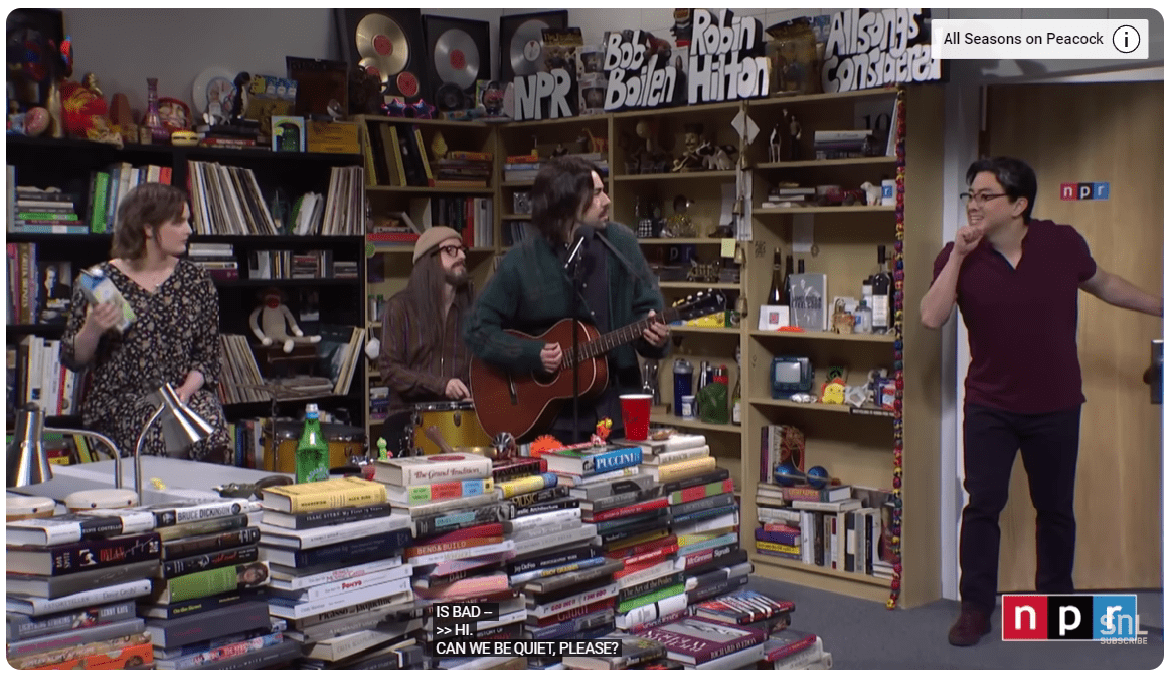
Yesterday’s blog post – “Has Radio Lost Its Muscle Memory” (And How To Get It Back)? – was directed at commercial radio loosening its grip on its traditional listening audience and taking well-calculated risks. The state of public radio in 2024 looks to be every bit as precarious.
How bad is it? Public radio stations must report their financial statements, so with some diligent web surfing, it is relatively easy to put together the economic vital signs for scores of stations throughout the system. That’s precisely what public radio ex-pat, Tim Eby, did last week in his always revealing “Three Things” newsletter on Substack. In essence, Tim said out loud what many in public radio have been wringing their hands over:
“Deficits Mounting for Public Radio from 2023”
It’s a grim look at what’s going on in public radio – and it isn’t pretty. Millions of dollars in revenue shortfalls and rising losses are impacting stations in all size markets from Chicago to Charlotte to Colorado. Here’s a snapshot of some of public radio’s biggest stations – the Queen Marys of the system – in 2023:
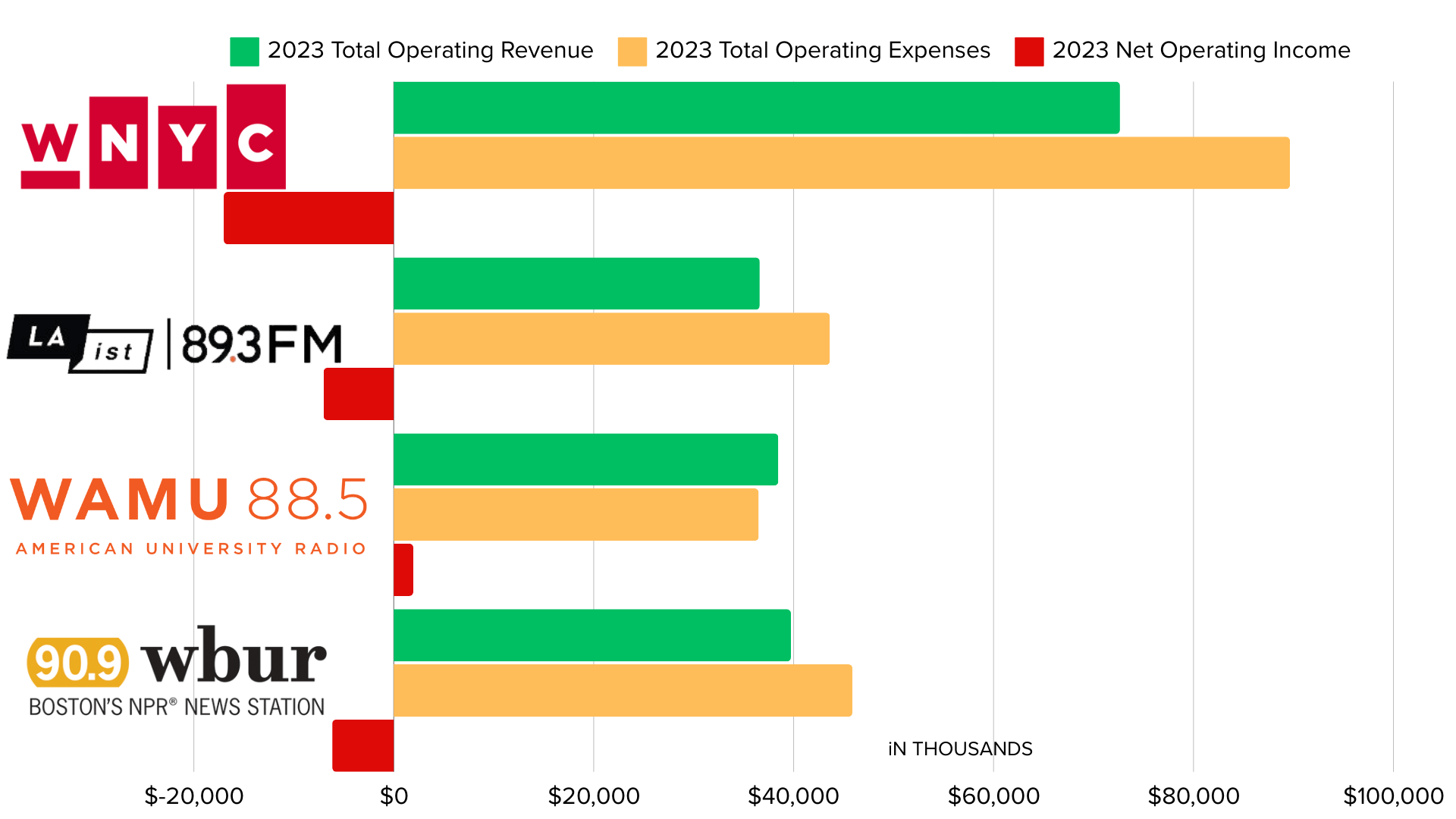
You’re reading the chart correctly if you’ve noted WNYC racked up operating losses of $17 million, KPCC/LAist came in at $7 million in the red, followed by WBUR (Boston) at -$6 million. The only station (on this chart) that managed a surplus was WAMU (Washington, D.C.).
It’s not much better in public radio’s medium markets either, many of which fell on hard financial times last year. And as Tim points out, many stations have also suffered severe losses in audience as well.
We’ve been dutifully tracking it in our Public Radio Techsurveys over the past 15 years. There are many metrics I could show you, but perhaps Net Promoter Scores are the best “35,000 foot” indicator of performance. Note the trend line since 2017 when scores were consistently in the 70s:
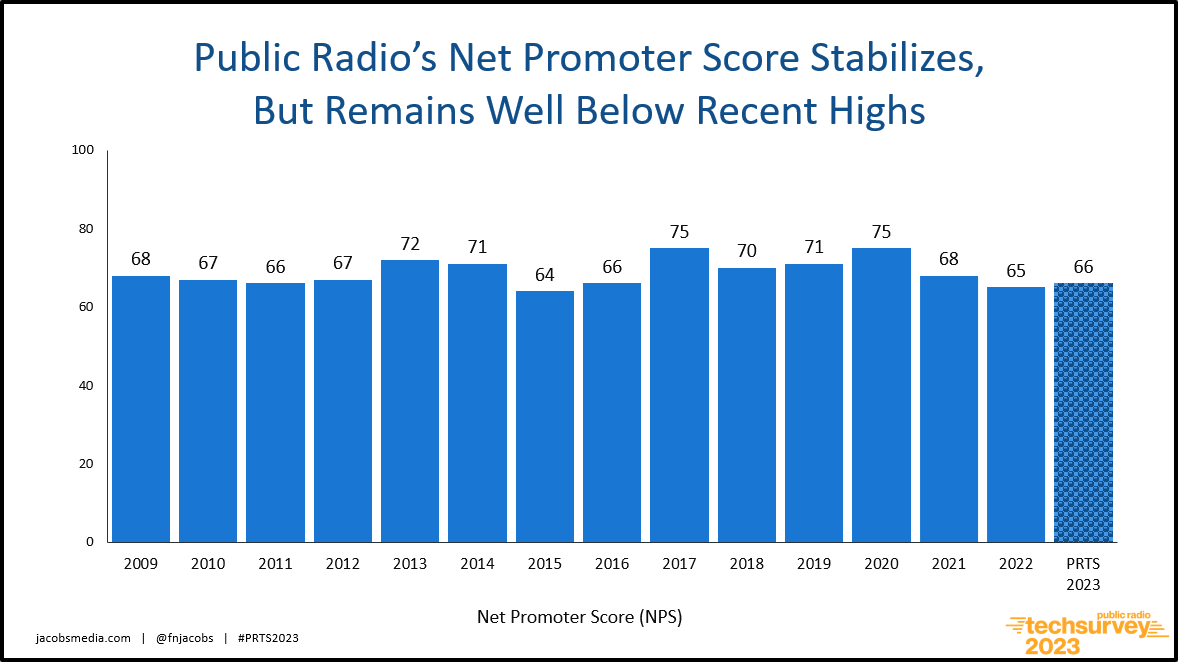
So, what explains this reversal of fortune, because it wasn’t that long ago when these financial reports were mostly in the black and many of these stations were consistently placing in the top 5 in adults 25-to-54 in many markets?
Tim’s POV (and there are many out there) is that while increased competition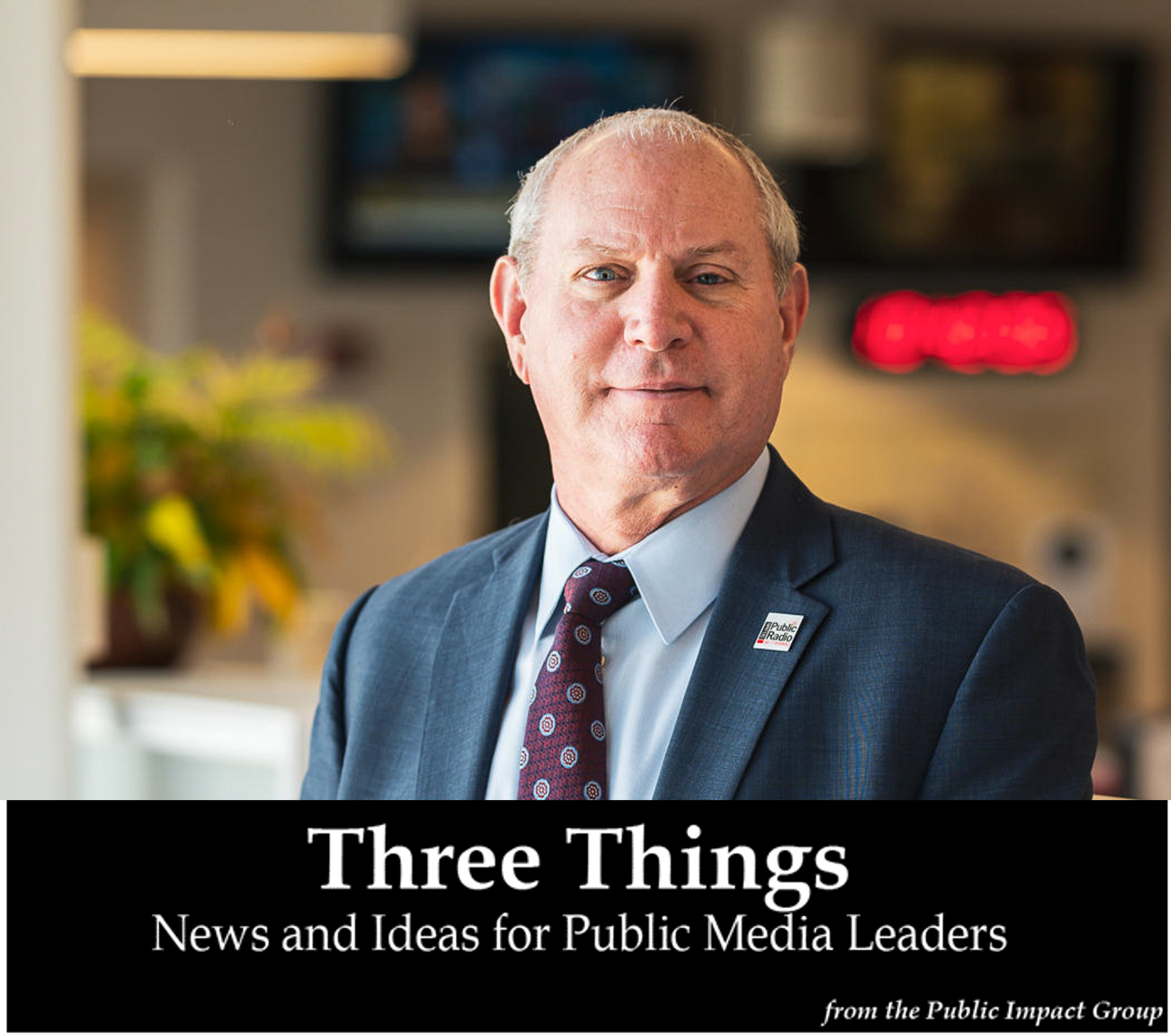 plays a role, along with the pandemic and a challenging news cycle, the news effort has lost its way:
plays a role, along with the pandemic and a challenging news cycle, the news effort has lost its way:
“I believe the most significant reason for this loss of listening is that public radio news programming has lost its focus on who its audience is and who it should be.”
Tim also mentions “staleness” as a co-conspiring reason why public radio listeners have begun to abandon their once-favorite radio stations.
In the go-to days of public radio, there were brilliant, quirky, unpredictable shows that provided whimsy and even relief from the news: Car Talk, A Prairie Home Companion, and others were at one time risky shows that went against the “Schweddy Balls” granola norms of the medium.
But, in fact, they brought joy, a few laughs, and variety to stations that needed a well-balanced diet of programs to survive, thrive, and raise sufficient funds in local pledge drives.
Reliance on some of that old muscle memory in public radio might not be a bad thing.
Tim also points to a tired (stale?) fundraising model public radio continues to use. Pledge drives are often torturous to those who give money each year, whether they are annual givers or “sustainers.” In last year’s PRTS 2024, we asked public radio core fans to explain their listening behavior during pledge drives. Here are the sobering results:

When more than half of a station’s most loyal listeners are “in-play” during fundraisers, the problem is obvious. Yet, no one in the system has come up with a better “donation mousetrap.” Public radio and pledge is a classic co-dependent relationship.
As you can see by the demographic breakouts, pledge drives cause collateral listening damage pretty much across the board. And oh-by-the-way, most stations schedule them during the spring and fall books.
Another culprit is what Tim Eby refers to as “The Podcasting Misadventure.” It is no secret that the lion’s share of the layoffs over the past year or so have occurred in podcasting divisions of some of the biggest public radio stations and at “the mothership,” NPR.
Despite the exuberance behind podcast listening data from studies, including this month’s Infinite Dial release, public radio has had a tough time making the business model work.
To a great degree, the legacy of podcasting more than a dozen years ago was born out of pubic radio, with NPR often leading the way. Many of the biggest names and companies in on-demand audio cut their teeth at NPR and public radio studios around the country.
While Tim posits that despite the high production costs and monetization problems, “podcasting is not going away.” But the model has challenged stations, both from a human and financial resources standpoint.
Once again, PRTS might tell part of this story. A look at weekly listening of podcasts versus weekly readership of local/regional newsletters tells a revealing story:
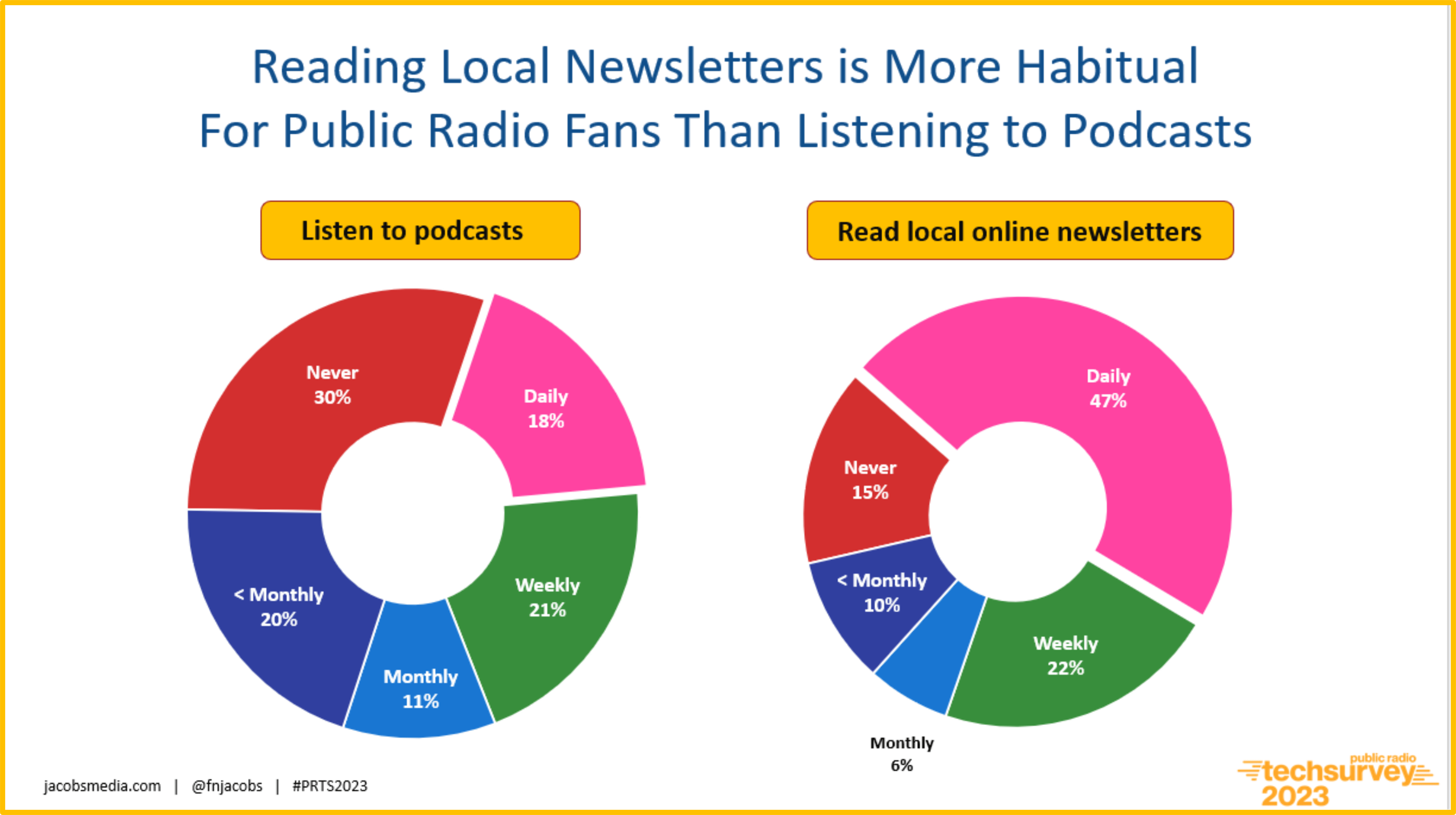
For podcasting versus newsletters, it may be a simple matter of “fishing where the fish are.” That said, the degree of difficulty of producing these content verticals varies drastically. At many public radio stations and networks, producing a successful podcast – consistently – is hard.
Finally, Tim’s exclamation point – “The Federation is Dying” – is all about NPR’s diminishing role in the public radio ecosystem. Aside from the always tenuous relationship between networks and affiliates, Tim notes that outside entities – including the many Axios Local outlets and CityCast local podcasts – are finding a way to make the editorial and financial spheres work.
Meantime, as NPR now once again experiences a leadership transition, it is anybody’s guess how their new CEO Katherine Maher will envision her organization’s future – and the future of public radio in America.
There was a time when NPR led the system with bold new programming, an ongoing effort to keep existing shows fresh and relevant, while providing research internally – and externally, providing actionable guidance to its member station.
NPR’s lack of presence since the Jarl Mohn Administration can only partially be blamed on the pandemic. Communication between leadership at NPR and those who head up hundreds of public radio fiefdoms has decreased to a trickle, furthering the animus and distrust that has always bubbled under.
Paul and I recently hosted a gathering of public radio execs at the Detroit airport. Overall, nine stations and 20 participants met for a day and a half to discuss salient issues, opportunities, and challenges facing their stations. The conversations were open, frank, and revealing.
And throughout the course of these discussions, NPR was not mentioned once – by anyone. In the past, NPR would have been that 800 pound gorilla – perhaps not represented officially, but always the straw that stirred the drink. And yet, NPR’s lack of presence – even in the context of complaints and vitriol – was nowhere to be seen.
NPR has experienced unusual turmoil and turnover in its ranks, and even found itself in a well-publicized war between former CEO John Lansing and the always flamboyant Elon Musk at Twitter/X. For an organization famous for its civility and calm, it was unusual – but refreshing – to witness NPR going toe to toe with one of the largest social media platforms in the world.
Last year amidst an advertising recession and a reversal of fortune for podcasting, NPR was forced to institute painful layoffs, impacting roughly 10% of its workforce. But in this regard, NPR is not alone – virtually every media outlet from the traditional to startups finds itself at something of a crossroads in these early days of 2024. Most are still sorting out their “why,” their business model, and the path forward.
But NPR has a distinct edge over most of them. It has the reputation for calm and civility as we find ourselves in a seemingly endless political and societal shit storm. And its brand trust scores have been consistently above most other news media players operating out of the U.S.
Over the years, NPR has grappled with some of the difficult and even existential choices facing their organization: to make their content available on satellite radio (they did), making their highly rated and respected news magazines (Morning Edition and All Things Considered) available on their NPR One app (they did, by resequencing segments from both magazines that better met listener needs using the data), and other network/affiliate issues, squabbles, and brouhahas where both sides rarely walk away happy.
Lately, NPR is showing signs they may need to more actively position themselves differently than other news organizations. A recent web ad pointed out some of the differences, a rare moment for the NPR team. Clarifying unique strengths is an imperative for every brand, especially one like NPR that does not typically toot its own horn. But it’s a necessity, given the fact that even many core public radio listeners aren’t especially aware of how their hometown station is funded.

NPR takes its share of knocks, even from other media players. And then there are the parodies. I have long believed that when they “send you up” (think Weird Al, if you must), they’re acknowledging your uniqueness. And if it’s a measure of stubborn respect, NPR has earned its fair share over the years.
My first memory is the famous SNL parody of an NPR cooking show, Delicious Dish, guest-starring Alec Baldwin as the memorable Pete Schweddy. It originally aired in 1998, and was reprised many times by a number of different guest hosts.
So, it should come as no surprise that NPR is once again comic fodder, this time for the imagination of Mike Judge, creator (or co-creator) of successful, irreverent animated series, including Beavis & Butthead and King of the Hill.
The new show, In The Know, features a fictional NPR host, Lauren Caspian, who is lambasted by the writers for his “wokeness.”
Here’s the official trailer:
What is interesting about some of these reviews of the show is how mean-spirited they are – not against the show, but against NPR.
In MediaPost’s TV Blog, featured columnist Adam Buckman goes on the attack, taking NPR’s brand, personalities, and style to task:
At one point, he describes “all the traits common among the woke generation – self-righteousness, the blaming of others, an exaggerated description of a situation and its cause and effect, the application of the buzzword ‘triggered,’ and violent ideation.”
But wait…there’s more.
The New York Times got in on the fun, using their review of In The Know by their TV critic, Mike Hale, to slam NPR (and public radio) around mercilessly. For a bastion of journalism, as the Times positions itself as, Hale goes after NPR, yes a direct competitor of his newspaper.
But first a hard shot at traditional media outlets – like radio stations. He praises animators Shadow Machine for its spot-on depiction of an air studio “that will bring a shudder to anyone who has worked long hours for mediocre pay in the legacy media business.” Last I checked, the Times still falls very much in that same category. And I can’t remember the last time I spoke with a print journalist who felt she was well-compensated for her efforts.
Hale’s depiction of the fictional Caspian: “He’s a particularly modern variety of monster; a smug, vain provocateur and throbbing ball of insecurity who has adopted performative wokeness as a personal brand and cudgel – Frasier Crane without the style or grace.”
Hale adds “(Caspian) constantly reveals himself to be guilty of exactly the kind of narrow-minded obtuseness he sees in everyone else.”
I’ve met a lot of NPR hosts and journalists over the years, along with the hundreds of scrappy, dedicated reporters, anchor, producers, interviewers, and program hosts at public radio stations all over the country. None – not a single one – could be described in this way.
It makes you wonder whether Judge was dissed on Fresh Air by Terry Gross. (She interviewed him 23 years ago). Or perhaps he never had a shot on the NPR quiz show, Wait, Wait…Don’t Tell Me!
Whatever the case, it is odd to go after as narrow a target as NPR, a news service many Americans don’t know about, don’t listen to, or both.
And finally, the newest parody of NPR, an encore performance by the new team at SNL, this time using the popular music feature, “Tiny Desk Concert,” as a torpedo aimed at many of the same values – and punchlines and cheap shots – Mike Judge went after:
Hilarious? On-point? Deserved? Maybe all of those things.
But there’s a point where you have to ask yourself whether they’re laughing with you, or at you.
All of this is to say that Eby’s main point – public radio’s focus and a redefinition of its “why” may be in order. And that process might begin with remembering its muscle memory – what made it successful in the first place.
You would expect me to say this, but research would help. That’s because anybody who thinks those old “givens” are still in play hasn’t been paying attention. In a world where there are 50 “breaking news” stories a day, public radio news departments – perhaps led or not so much by NPR News – has still not faced up to these changes in the way news breaks, is covered, and is analyzed for truth and clarity.
What is NPR’s purpose as a program supplier to the hundreds of its stations who have depended on its innovation, creativity, and resourcefulness all these years? Sadly – as already shown – more programs (OK, parodies) have been created about NPR than by NPR in recent years.
What’s in the pipeline? Is there a pipeline? And more podcasts does not appear to be an answer that would seem viable or helpful to NPR’s many affiliates.
Many local public radio stations believe the burden of program creation and production will now fall squarely on their local shoulders.
How can research play a role in defining where to go from here? Designed and conducted well by experts who know the space and are willing to face its results head-on, it can provide the “data radar” organizations need for planning for today and for down the road.
 I’m not going to suggest that our PRTS studies are the solutions because they’re not. But as we start the process of designing the new 2024 version, fielded in June/July, we will have an eye on all of the issues discussed in this post – and then some.
I’m not going to suggest that our PRTS studies are the solutions because they’re not. But as we start the process of designing the new 2024 version, fielded in June/July, we will have an eye on all of the issues discussed in this post – and then some.
As a syndicated study conducted mostly among core partisans, PRTS has limitations. But it is trackable, local, affordable and flexible – all qualities that can help all the players from the biggest starships in the system to small town community stations define a smart and sensible path forward.
Its makeup of mostly fans has merits, too. Erosion among P1s is a reality – the people who listen the most and donate the most. A focus on the fringe at this point will simply take public radio even further off course than it is now.
Muscle memory is a weird concept. It’s back there somewhere, and there are still people roaming around the wilderness who understand its importance without being the least bit nostalgic about it. It often takes a while to get it back, but it is in the DNA of public radio stations and even more importantly, the people who have devoted their careers to building something important.
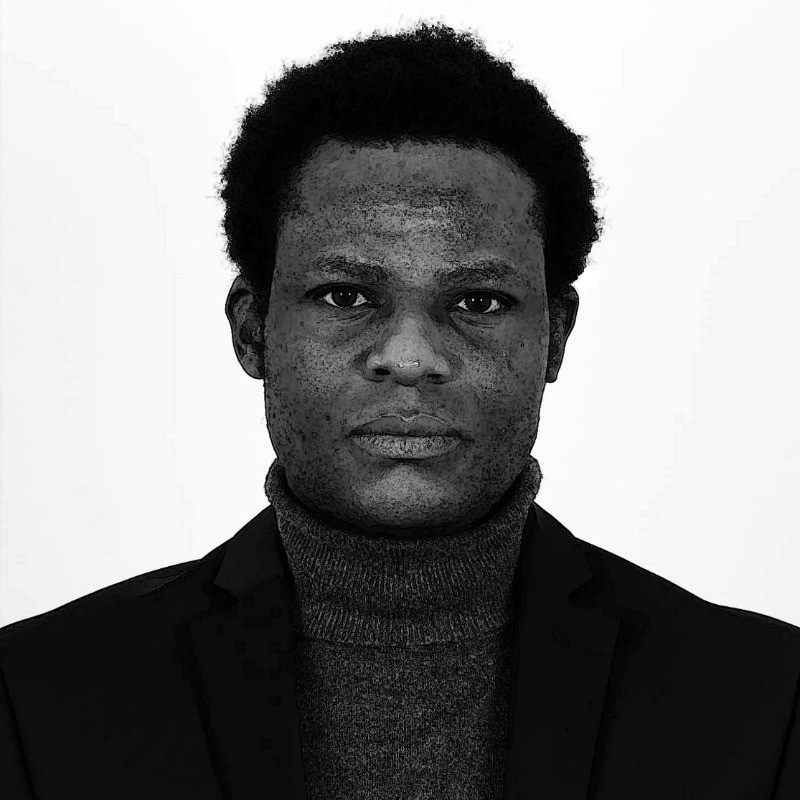
I am partial to this line from poet/philosopher Oscar Auliq-Ice (pictured):
“Complaining solves nothing but creative problem solving amongst people with a common focus will produce solutions.”
We can only hope.
Correction: The original version of this post stated NPR’s two newsmagazines were excluded from the NPR One app. In fact, content segments from both “ME” and “ATC” were resequenced in the app based on listener data to create a better mobile app experience. Apologies for the error. – FJ
- For Radio, The Perils Of Rebranding - May 30, 2025
- There’s No Failure In Radio - May 29, 2025
- It’s Not An Innovation If You Can’t Make It Work – And Last - May 28, 2025




These are the sobering questions. “ What’s in the pipeline? Is there a pipeline?”. In addition the public media newsrooms must take a hard look at tone, slant and bias. It’s oxymoronic to feature mostly alt/indie music on pub radio news features and then wonder why the audience is primarily liberal leaning and white; as one small example.
I am alive and well, atonement is the accepted form of self involvement and the realization that only changing the things that made such things happen. I/E screen time.
Pipeline has always been secondary to the majority. It has only been utilized to in circumstances that were seen as hopeless. To see, know and have to endure the challenges that were already present and heading in ony one direction, when attempting to divert the flow, ensued a volatile reaction. Causing one problem area to become two. It takes a team effort to overcome this situation. Without seeing the problems they cant be successfully repaired.
The problematic areas that the lost audience was expressing such actions as finding alternative wavelengths as a needed response were updated several months prior to the mass exodus was underway. The audience then embarked upon a 12 month hiatus, which caused a huge revenue loss for the corporate sector. This could only be interpreted as, it wasnt the technology that encumbered, the broadcast, but rather discontent in the format of the 22 year now needed variety. Nothing wrong with variety that is safely censored, but even that was limited to only one listener.
I’ve been part of our local station’s fundraising efforts since 2005, and can attest to the difficulty of explaining to the listener why we’re interrupting “Morning Edition” and “All Things Considered” but agree that it’s necessary to do that to explain how the service is funded- -which we do frequently. If there’s a bright spot, those who leave the station for another choice will return once that “other” choice goes into an incessant commercial break which, in many cases, is more irritating than the pledge breaks. Of course the number of media choices (podcasts, streamers, satellite..) on the increase has an effect of diluting the number of overall listeners, and contributors. The fact that KPBS is consistently at or near the top of the San Diego Nielsen shows the importance of the station and the service it provides. I’m sure the powers at PBS, both locally and nationally are going to see this study and act accordingly, in contrast to many commercial counterparts. Thanks for letting us know!
I am a retired (commercial) radio news director and as such, a long-time listener to NPR. But in recent months I have drastically reduced my time spent listening. I still wake up to Morning Edition, but can no longer stomach the sanctimonious political correctness of All Things Considered, and I never bother with other NPR programming. What finally pushed me away was the capitulation to leftist language policing. That gives rise to such absurd constructions as “pregnant people, “LatinX ” (offensive to many Spanish speakers), “abortion care,” “people experiencing homelessness” (never call people homeless even though they are) and — I swear I heard this on an NPR broadcast — “people with male reproductive organs.” But the below-linked article expresses my sentiments much better than I can, and it’s from an NPR employee.
https://www.thefp.com/p/npr-editor-how-npr-lost-americas-trust
I don’t know if these testimonials about “why I no longer listen to NPR” are representative of the audience as a whole, but I can’t help but to notice I’ve yet to hear a single person stating the opposite. That is, “Wow I recently tuned into NPR and I loved it, I never listened before but now I have it on all the time.” Certainly seems they’re not picking up any NEW listeners here.
To the numbers above, Chicago Public Radio recently announced the closing of Vocalo, a kind of smaller “sister” station near WBEZ on the dial and which aimed at a younger “urban” audience. There’s something about considering that an investment in the future, but at least one report claimed they had “an audience of 11,000 listeners weekly,” numbers that had “been stagnant since its launch in 2007.”That is staggering. To have an “experiment” going for 17 years and no growth.
My experience is very much the same as Mark’s. But as a fossil (retired) who listens to Morning Edition at home, I have the option of switching to a stream of the show from the adjacent state when my own pubcaster goes into begging mode. Fortunately, the two organizations don’t coordinate their drives; the weather forecast is nearly the same, too!
Of course, listeners in their cars might not have my option (unless they’re willing to burn cell data), so Mark’s solution there seems the only one unless they carry portable media with them. (CD, anyone?) As to funding, I used to live in the UK and enjoyed listening to the BBC, but their revenue model is not without its own set of problems–I doubt any proposal to emulate it in the US would attract enough support to get a hearing. The opportunity to implement conditional access (a la XM) in the IBOC technology has long passed, and I frankly don’t know how NPR and its member stations are going to escape the corner they’ve painted themselves into. Meanwhile, I’ll continue listening until the credits roll.
It is also disgusting that NPR’s subpar programming and on air begging is propped up and subsidized by government funds.
“At one point, he describes “all the traits common among the woke generation – self-righteousness, the blaming of others, an exaggerated description of a situation and its cause and effect, the application of the buzzword ‘triggered,’ and violent ideation.”
Definitely does not only describe one side of the aisle. I could argue that a lot of contemporary talk radio that claims to oppose “wokeness” displays many of the same traits – blame, exaggeration/distortion, and idealizing violence of the revolutionary sort.
From a broadcasting standpoint, it’s rarely entertaining regardless of who’s doing it. But while NPR may not appeal to everyone from a tone perspective, or the depth or nuance of the issues they cover, it’s the nature of longform media.
I’ve read the Free Press article and I’m skeptical that NPR’s challenges with audience were sudden or self-inflicted. There’s been a history of attacks on NPR from competing media and for political gain. News and talk media has become increasingly fragmented and divisive. So the idea that NPR can suddenly effect some change that wins the trust of people told by those they trust and vote for that it’s all propaganda is unlikely. There’s no magic wand they can wave to change the hearts of that audience towards NPR. And stylistically it doesn’t play to much of those sorts of listeners either.
We live in an era of echo chambers and self-selected affirmations of existing belief. I would venture that NPR has better reporting and higher standards than most outlets, but that’s always going to lead to bias claims because of approach and story selection (and you can’t cover every story fully at the same time. There’s too much news in the world.) So understandably, NPR would gravitate towards its biggest listener base – upper income, educated, mostly coastal or urban listeners.
You can attempt to diversify it, and I think there’s always work to be done there. Vocalo wasn’t successful, but a station like Radio Milwaukee is. Some of the public radio music stations have made great strides. But ultimately, while it’s a public service media, it’s also in the business and attracts a certain profile of listener. I hope these stations can grow and recover revenue, but I’m not sure that chasing an idealistic and unlikely perception of “balance” is the way to do it.
I find the production values and reporting standards of the BBC, CBC and NPR impressive. As someone who can make up their own mind, and understand perspective, the “bias” is something I can agree with or filter out. Either way, I think especially in regions where coverage of the state level legislative process is lacking commercially, there are NPR affiliates doing great and necessary work to fill in that news gap that commercial stations aren’t. And that, ideally, leads to a better informed public that engages more with their local and state issues, regardless of what their politics are. I think radio is elevated by having public radio present on the dial and thriving.